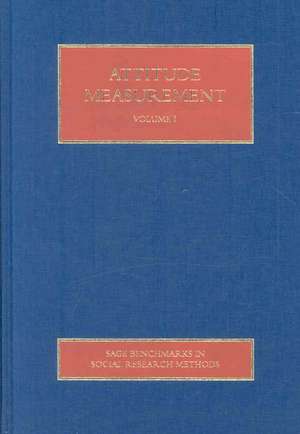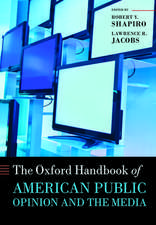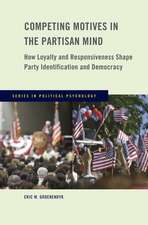Attitude Measurement: SAGE Benchmarks in Social Research Methods
Editat de Caroline Roberts, Roger Jowellen Limba Engleză Hardback – 22 oct 2008
Din seria SAGE Benchmarks in Social Research Methods
- 26%
 Preț: 4279.01 lei
Preț: 4279.01 lei - 14%
 Preț: 4681.11 lei
Preț: 4681.11 lei - 14%
 Preț: 4681.02 lei
Preț: 4681.02 lei - 9%
 Preț: 4903.72 lei
Preț: 4903.72 lei - 26%
 Preț: 4719.73 lei
Preț: 4719.73 lei - 26%
 Preț: 4717.99 lei
Preț: 4717.99 lei - 14%
 Preț: 4681.64 lei
Preț: 4681.64 lei - 14%
 Preț: 4924.68 lei
Preț: 4924.68 lei - 9%
 Preț: 4664.11 lei
Preț: 4664.11 lei - 14%
 Preț: 4680.54 lei
Preț: 4680.54 lei - 14%
 Preț: 4922.96 lei
Preț: 4922.96 lei - 26%
 Preț: 4501.69 lei
Preț: 4501.69 lei - 26%
 Preț: 4592.44 lei
Preț: 4592.44 lei - 26%
 Preț: 4279.57 lei
Preț: 4279.57 lei - 9%
 Preț: 4663.69 lei
Preț: 4663.69 lei - 11%
 Preț: 4548.15 lei
Preț: 4548.15 lei - 11%
 Preț: 4550.66 lei
Preț: 4550.66 lei - 26%
 Preț: 4499.70 lei
Preț: 4499.70 lei - 26%
 Preț: 4501.07 lei
Preț: 4501.07 lei - 26%
 Preț: 4279.82 lei
Preț: 4279.82 lei - 11%
 Preț: 4551.41 lei
Preț: 4551.41 lei - 26%
 Preț: 4717.90 lei
Preț: 4717.90 lei - 26%
 Preț: 4499.91 lei
Preț: 4499.91 lei - 11%
 Preț: 4550.81 lei
Preț: 4550.81 lei - 11%
 Preț: 5522.70 lei
Preț: 5522.70 lei - 26%
 Preț: 4280.71 lei
Preț: 4280.71 lei - 11%
 Preț: 4549.51 lei
Preț: 4549.51 lei - 26%
 Preț: 4719.93 lei
Preț: 4719.93 lei - 16%
 Preț: 4551.95 lei
Preț: 4551.95 lei - 11%
 Preț: 4553.06 lei
Preț: 4553.06 lei - 26%
 Preț: 4719.73 lei
Preț: 4719.73 lei - 26%
 Preț: 4595.85 lei
Preț: 4595.85 lei - 26%
 Preț: 4500.91 lei
Preț: 4500.91 lei - 11%
 Preț: 4551.95 lei
Preț: 4551.95 lei - 26%
 Preț: 4719.73 lei
Preț: 4719.73 lei - 11%
 Preț: 4549.05 lei
Preț: 4549.05 lei - 11%
 Preț: 4784.30 lei
Preț: 4784.30 lei - 26%
 Preț: 4279.46 lei
Preț: 4279.46 lei - 26%
 Preț: 4500.07 lei
Preț: 4500.07 lei - 26%
 Preț: 4500.47 lei
Preț: 4500.47 lei - 26%
 Preț: 4497.42 lei
Preț: 4497.42 lei - 26%
 Preț: 4278.96 lei
Preț: 4278.96 lei - 26%
 Preț: 4715.29 lei
Preț: 4715.29 lei - 26%
 Preț: 4278.75 lei
Preț: 4278.75 lei - 11%
 Preț: 4551.49 lei
Preț: 4551.49 lei - 26%
 Preț: 4279.37 lei
Preț: 4279.37 lei - 26%
 Preț: 4281.18 lei
Preț: 4281.18 lei - 26%
 Preț: 4280.81 lei
Preț: 4280.81 lei - 26%
 Preț: 4279.44 lei
Preț: 4279.44 lei
Preț: 4662.77 lei
Preț vechi: 5123.92 lei
-9% Nou
Puncte Express: 6994
Preț estimativ în valută:
892.50€ • 969.78$ • 750.19£
892.50€ • 969.78$ • 750.19£
Carte disponibilă
Livrare economică 31 martie-14 aprilie
Livrare express 15-21 martie pentru 119.80 lei
Preluare comenzi: 021 569.72.76
Specificații
ISBN-13: 9781412928403
ISBN-10: 1412928400
Pagini: 1632
Dimensiuni: 156 x 234 x 117 mm
Greutate: 3 kg
Ediția:Four-Volume Set
Editura: SAGE Publications
Colecția Sage Publications Ltd
Seria SAGE Benchmarks in Social Research Methods
Locul publicării:London, United Kingdom
ISBN-10: 1412928400
Pagini: 1632
Dimensiuni: 156 x 234 x 117 mm
Greutate: 3 kg
Ediția:Four-Volume Set
Editura: SAGE Publications
Colecția Sage Publications Ltd
Seria SAGE Benchmarks in Social Research Methods
Locul publicării:London, United Kingdom
Cuprins
VOLUME 1: BASIC CONCEPTS AND HISTORICAL FOUNDATIONS
Attitudes versus actions - LaPiere, R.T.
Attitudes - Allport, G.W.
The sociological significance of measurable attitudes - LaPiere, R.T.
A consideration of beliefs, and their role in attitude measurement - Fishbein, M.
Attitude measurement: a cognitive perspective - Tourangeau, R.
A simple theory of the survey response: Answering questions versus revealing preferences - Zaller, J. and Feldman, S.
Measuring social distances - Bogardus, E.S.
Attitudes can be measured - Thurstone, L.L.
A technique for measurement of attitudes - Likert, R.
A comparison of the Thurstone and Likert techniques of attitude scale construction - Edwards, A.L. and Kenney, K.C.
A basis for scaling qualitative data - Guttman, L.
A technique for the construction of attitude scales - Edwards, A.L. and Kilpatrick, F.P.
Attitude Measurement - Osgood, C.E., Suci, G.J. and Tannenbaum, P.H.
A technique and a model for multi-dimensional attitude scaling - Abelson, R.P.
Latent structure analysis - Lazarsfeld, P.F.
Convergent and discriminant validation by the multitrait-multimethod matrix - Campbell, D.T. and Fiske, D.W.
Reliability and validity assessment in attitude measurement - Bohrnstedt, G.W.
VOLUME 2: DESIGNING DIRECT MEASURES
Open versus closed questions - Schumann, H. and Presser, S.
Strong arguments and weak evidence: The openosed questioning controversy of the 1940s - Converse, J.M.
The wording of questions - Rugg, D. and Cantril, H.
Experiments in wording opinion questions - Kalton, G., Collins, M., and Brook, L.
Three-point Likert scales are good enough - Jacoby, J. and Matell, M.S.
Are three-point scales always good enough? - Lehman, D.R., and Hulbert, J.
The relationship between number of response categories and reliability of Likert-type questionnaires - Masters, J.R.
The optimal number of response alternatives for a scale: A review - Cox, E.P.
Feeling thermometers versus 7-point scales: Which are better? - Alwin, D.F.
How often is often? - Hakel, M.D.
Often is where you find it - Chase, C.I.
Vague quantifiers - Bradburn, N.M. and Miles, C.
Extreme response on a Likert scale - Albaum, G. and Murphy, B.D.
"Don't know": Item ambiguity or respondent uncertainty? - Coombs, C.H. and Coombs, L.C.
Decisions about ignorance: Knowing that you don't know - Glucksberg, S. and McCloskey, M.
"No-opinion" filters: A cognitive perspective - Hippler, H.J. and Schwarz, N.
Should we take don't know for an answer? - Gilljam, M., and Granberg, D.
The impact of no opinion response options on data quality: Non-attitude reduction or an invitation to satisfice? - Krosnick, J.A., Holbrook, A.L., Berent, M.K., Carson, R.T., Hanemann, W.M., Kopp, R.J., Mitchell, R.C., Presser, S., Ruud, P.A., Smith, V.K., Moody, W.R., Green, M.C., and Conaway, M.
Response alternatives: The impact of their choice and presentation order. - Schwarz, N. and Hippler, H.J.
The effect of ordinal position upon responses to items in a checklist - Campbell, D.T. and Mohr, P.J.
The effects of offering a middle response option with opinion questions - Kalton, G., Roberts, J. and Holt, D.
The middlemost choice on attitude items: Ambivalence, neutrality, or uncertainty - Klopfer, F.J. and Madden, T.M.
Experiments with the middle response alternative in survey questions - Bishop, G.F.
The measurement of attitudes - Krosnick, J.A., Judd, C.M. and Wittenbrink, B.
The retrospective question - Fink, R.
VOLUME 3: OBSTACLES TO DIRECT MEASUREMENT
Response sets and test validity - Cronbach, L.J.
The great response-style myth - Rorer, L.G.
Attitude intensity, importance and certainty and susceptibility to response effects - Krosnick, J.A. and Schuman, H.
Response strategies for coping with the cognitive demands of attitude measures in surveys - Krosnick, J.A.
Effects of presenting one versus two sides of an issue in survey questions - Bishop, G.F., Oldendick, R.W. and Tuchfarber, A.J.
Not forbidding isn't allowing: The cognitive basis of the forbid-allow symmetry - Hippler, H.J. and Schwarz, N.
The effect of question order on responses - Bradburn, N.M. and Mason, W.M.
An evaluation of a cognitive theory of response-order effects in survey measurement - Krosnick, J.A. and Alwin, D.F.
Context and congruity in survey questionnaires - Schuman, H., Kalton, G. and Ludwig, J.
Cognitive processes underlying context effects in attitude measurement - Tourangeau, R. and Rasinski, K.A.
Acquiescence: Measurement and theory - Martin, J.
Controlling for acquiescence response set in scale development - Winkler, J.D., Kanouse, D.E., and Ware, J.E.
Privacy and the expression of white racial attitudes - Krysan, M.
The effect of black and white interviewers in black responses - Schuman, H. and Converse, J.M.
The nature of belief systems in the mass public - Converse, P.E.
Pseudo-opinions on public affairs - Bishop, G.F., Oldendick, R.W., Tuchfarber, A.J. and Bennett, S.E.
Public opinion and public ignorance: The fine line between attitudes and nonattitudes - Schumann, H. and Presser, S.
Question wording effects: Presenting one or both sides of the case - Hedges, B.M.
Nonattitudes: A review and evaluation - Smith, T.W.
VOLUME 4: EXPANDING THE MEASUREMENT HORIZONS
The indirect assessment of social attitudes - Campbell, D.T.
New technologies for the direct and indirect assessment of attitudes - Dovidio, J.F. and Fazio, R.H.
Evidence for racial prejudice at the implicit level and its relationship with questionnaire measures - Wittenbrink, B., Judd, C.M. and Park, B.
Measuring individual differences in implicit cognition: The implicit association test. - Greenwald, A.G., McGhee, D.E. and Schwartz, J.L.K.
Implicit attitude measures: Consistency, stability and convergent validity - Cunningham, W.A., Preacher, K.J. and Banaji, M.R.
Implicit measures in social cognition research: Their meaning and uses - Fazio, R.H. and Olson, M.A.
Physiological techniques of attitude measurement - Mueller, D.J.
Galvanic skin response to negro and white experimenters - Rankin, R.E. and Campbell, D.T.
Attitude and pupil size - Hess, E.H.
A projective method for the study of attitudes - Proshansky, H.M.
Measuring attitudes by error-choice: an indirect method - Hammond, K.R.
Asking the embarrassing question - Barton, A.M.
The lost-letter technique: A tool for social research - Milgram, S., Mainn, L. and Harter, S.
Twenty years of bogus pipeline research: A critical review and meta-analysis - Roese, N.J. and Jamieson, D.W.
Randomized response: A survey technique for eliminating evasive answer bias - Warner, S.L.
A multiple-indicator approach to attitude measurement - Cook, S.W. and Selltiz, C.
Response latency as a signal to question problems in survey research - Bassili, J.N. and Scott, B.S.
Considered opinions: Deliberative polling in Britain - Luskin, R.C., Fishkin, J.S. and Jowell, R.
A different take on the deliberative poll: Information, deliberation and attitude constraint - Sturgis, P., Roberts, C. and Allum, N.
Equivalence in cross-national research - Przeworski, A and Teune, H.
Developing comparable questions in cross-national surveys - Smith, T.
Social desirability bias: A demonstration and technique for it reduction - Gordon, R.A.
Attitudes versus actions - LaPiere, R.T.
Attitudes - Allport, G.W.
The sociological significance of measurable attitudes - LaPiere, R.T.
A consideration of beliefs, and their role in attitude measurement - Fishbein, M.
Attitude measurement: a cognitive perspective - Tourangeau, R.
A simple theory of the survey response: Answering questions versus revealing preferences - Zaller, J. and Feldman, S.
Measuring social distances - Bogardus, E.S.
Attitudes can be measured - Thurstone, L.L.
A technique for measurement of attitudes - Likert, R.
A comparison of the Thurstone and Likert techniques of attitude scale construction - Edwards, A.L. and Kenney, K.C.
A basis for scaling qualitative data - Guttman, L.
A technique for the construction of attitude scales - Edwards, A.L. and Kilpatrick, F.P.
Attitude Measurement - Osgood, C.E., Suci, G.J. and Tannenbaum, P.H.
A technique and a model for multi-dimensional attitude scaling - Abelson, R.P.
Latent structure analysis - Lazarsfeld, P.F.
Convergent and discriminant validation by the multitrait-multimethod matrix - Campbell, D.T. and Fiske, D.W.
Reliability and validity assessment in attitude measurement - Bohrnstedt, G.W.
VOLUME 2: DESIGNING DIRECT MEASURES
Open versus closed questions - Schumann, H. and Presser, S.
Strong arguments and weak evidence: The openosed questioning controversy of the 1940s - Converse, J.M.
The wording of questions - Rugg, D. and Cantril, H.
Experiments in wording opinion questions - Kalton, G., Collins, M., and Brook, L.
Three-point Likert scales are good enough - Jacoby, J. and Matell, M.S.
Are three-point scales always good enough? - Lehman, D.R., and Hulbert, J.
The relationship between number of response categories and reliability of Likert-type questionnaires - Masters, J.R.
The optimal number of response alternatives for a scale: A review - Cox, E.P.
Feeling thermometers versus 7-point scales: Which are better? - Alwin, D.F.
How often is often? - Hakel, M.D.
Often is where you find it - Chase, C.I.
Vague quantifiers - Bradburn, N.M. and Miles, C.
Extreme response on a Likert scale - Albaum, G. and Murphy, B.D.
"Don't know": Item ambiguity or respondent uncertainty? - Coombs, C.H. and Coombs, L.C.
Decisions about ignorance: Knowing that you don't know - Glucksberg, S. and McCloskey, M.
"No-opinion" filters: A cognitive perspective - Hippler, H.J. and Schwarz, N.
Should we take don't know for an answer? - Gilljam, M., and Granberg, D.
The impact of no opinion response options on data quality: Non-attitude reduction or an invitation to satisfice? - Krosnick, J.A., Holbrook, A.L., Berent, M.K., Carson, R.T., Hanemann, W.M., Kopp, R.J., Mitchell, R.C., Presser, S., Ruud, P.A., Smith, V.K., Moody, W.R., Green, M.C., and Conaway, M.
Response alternatives: The impact of their choice and presentation order. - Schwarz, N. and Hippler, H.J.
The effect of ordinal position upon responses to items in a checklist - Campbell, D.T. and Mohr, P.J.
The effects of offering a middle response option with opinion questions - Kalton, G., Roberts, J. and Holt, D.
The middlemost choice on attitude items: Ambivalence, neutrality, or uncertainty - Klopfer, F.J. and Madden, T.M.
Experiments with the middle response alternative in survey questions - Bishop, G.F.
The measurement of attitudes - Krosnick, J.A., Judd, C.M. and Wittenbrink, B.
The retrospective question - Fink, R.
VOLUME 3: OBSTACLES TO DIRECT MEASUREMENT
Response sets and test validity - Cronbach, L.J.
The great response-style myth - Rorer, L.G.
Attitude intensity, importance and certainty and susceptibility to response effects - Krosnick, J.A. and Schuman, H.
Response strategies for coping with the cognitive demands of attitude measures in surveys - Krosnick, J.A.
Effects of presenting one versus two sides of an issue in survey questions - Bishop, G.F., Oldendick, R.W. and Tuchfarber, A.J.
Not forbidding isn't allowing: The cognitive basis of the forbid-allow symmetry - Hippler, H.J. and Schwarz, N.
The effect of question order on responses - Bradburn, N.M. and Mason, W.M.
An evaluation of a cognitive theory of response-order effects in survey measurement - Krosnick, J.A. and Alwin, D.F.
Context and congruity in survey questionnaires - Schuman, H., Kalton, G. and Ludwig, J.
Cognitive processes underlying context effects in attitude measurement - Tourangeau, R. and Rasinski, K.A.
Acquiescence: Measurement and theory - Martin, J.
Controlling for acquiescence response set in scale development - Winkler, J.D., Kanouse, D.E., and Ware, J.E.
Privacy and the expression of white racial attitudes - Krysan, M.
The effect of black and white interviewers in black responses - Schuman, H. and Converse, J.M.
The nature of belief systems in the mass public - Converse, P.E.
Pseudo-opinions on public affairs - Bishop, G.F., Oldendick, R.W., Tuchfarber, A.J. and Bennett, S.E.
Public opinion and public ignorance: The fine line between attitudes and nonattitudes - Schumann, H. and Presser, S.
Question wording effects: Presenting one or both sides of the case - Hedges, B.M.
Nonattitudes: A review and evaluation - Smith, T.W.
VOLUME 4: EXPANDING THE MEASUREMENT HORIZONS
The indirect assessment of social attitudes - Campbell, D.T.
New technologies for the direct and indirect assessment of attitudes - Dovidio, J.F. and Fazio, R.H.
Evidence for racial prejudice at the implicit level and its relationship with questionnaire measures - Wittenbrink, B., Judd, C.M. and Park, B.
Measuring individual differences in implicit cognition: The implicit association test. - Greenwald, A.G., McGhee, D.E. and Schwartz, J.L.K.
Implicit attitude measures: Consistency, stability and convergent validity - Cunningham, W.A., Preacher, K.J. and Banaji, M.R.
Implicit measures in social cognition research: Their meaning and uses - Fazio, R.H. and Olson, M.A.
Physiological techniques of attitude measurement - Mueller, D.J.
Galvanic skin response to negro and white experimenters - Rankin, R.E. and Campbell, D.T.
Attitude and pupil size - Hess, E.H.
A projective method for the study of attitudes - Proshansky, H.M.
Measuring attitudes by error-choice: an indirect method - Hammond, K.R.
Asking the embarrassing question - Barton, A.M.
The lost-letter technique: A tool for social research - Milgram, S., Mainn, L. and Harter, S.
Twenty years of bogus pipeline research: A critical review and meta-analysis - Roese, N.J. and Jamieson, D.W.
Randomized response: A survey technique for eliminating evasive answer bias - Warner, S.L.
A multiple-indicator approach to attitude measurement - Cook, S.W. and Selltiz, C.
Response latency as a signal to question problems in survey research - Bassili, J.N. and Scott, B.S.
Considered opinions: Deliberative polling in Britain - Luskin, R.C., Fishkin, J.S. and Jowell, R.
A different take on the deliberative poll: Information, deliberation and attitude constraint - Sturgis, P., Roberts, C. and Allum, N.
Equivalence in cross-national research - Przeworski, A and Teune, H.
Developing comparable questions in cross-national surveys - Smith, T.
Social desirability bias: A demonstration and technique for it reduction - Gordon, R.A.
Descriere
Attitude Measurement is one of the most essential areas within social psychology. International figures, within this field, Jowell and Roberts bring together the most inclusive collection embracing methodological to theoretical issues.










